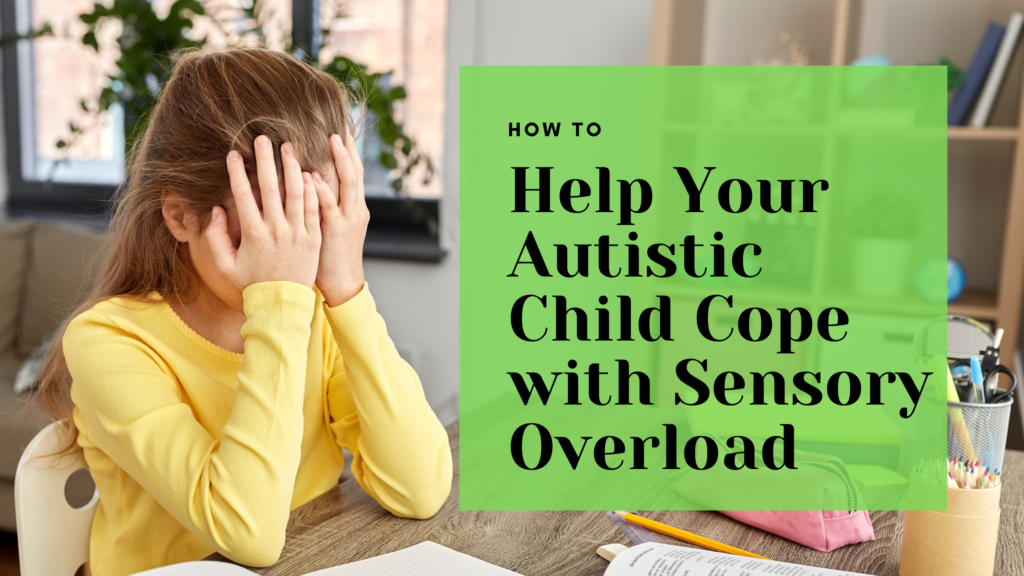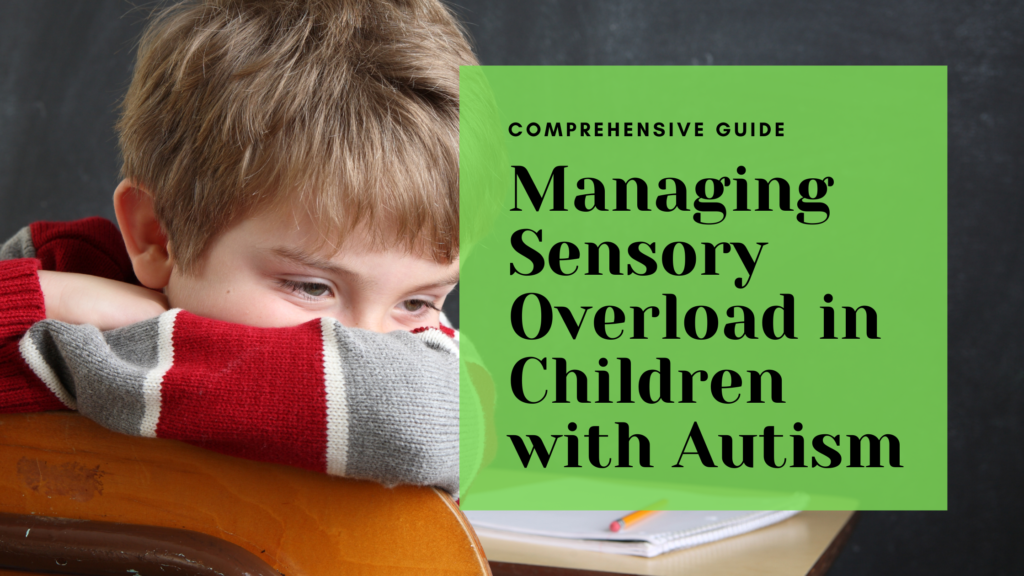I. Introduction
Children with autism often face sensory processing challenges that can make everyday experiences overwhelming. Sensory processing refers to how the brain interprets and responds to information from the senses, like sound, touch, and light. Many autistic children experience sensory overload, which can lead to anxiety, meltdowns, and emotional dysregulation. Sensory tools are designed to help manage these sensory challenges and provide calming effects for autistic children.
The purpose of this article is to guide parents and caregivers in using sensory tools to calm and regulate an autistic child. We will cover the different types of sensory tools, how they work, and practical tips on using them at home, in public, and at school. By understanding and utilizing these tools, parents can create a more supportive environment for their children.
II. Understanding Sensory Processing and Its Impact on Autistic Children
Sensory processing refers to the way the brain takes in, organizes, and responds to sensory information. For children with autism, this process may not work smoothly, leading to either sensory overload (when there is too much sensory input) or sensory underload (when not enough sensory input is received). This can result in anxiety, frustration, and meltdowns.
There are two common types of sensory behaviors in autistic children: sensory-seeking and sensory-avoiding. Sensory-seeking children crave more sensory input and may engage in behaviors like spinning, jumping, or making loud noises to satisfy their need for stimulation. On the other hand, sensory-avoiding children are overwhelmed by sensory input and may cover their ears, avoid bright lights, or dislike being touched.
Common sensory challenges include sensitivity to sound, touch, light, and movement. These sensitivities can trigger stress or discomfort, making everyday situations challenging. Sensory tools help address these challenges by providing sensory input that helps the child feel more regulated and calm.
III. Types of Sensory Tools and How They Work
Tactile Tools
Tactile tools engage a child’s sense of touch. These tools can help with tactile sensitivities by providing textures that are calming or stimulating, depending on the child’s needs. Examples include:
- Sensory brushes: Used to provide calming deep pressure through brushing on the skin.
- Fidget toys: Small handheld objects with different textures that children can squeeze or twist to help them stay focused.
- Textured fabrics: Soft or rough fabrics that offer different tactile sensations to explore.
Proprioceptive Tools
Proprioception refers to body awareness. Proprioceptive tools provide deep pressure or movement to help a child feel grounded and in control. These tools are often very calming for children who seek proprioceptive input. Examples include:
- Weighted blankets: Provide deep pressure to help calm the nervous system.
- Compression vests: Give a gentle squeeze around the body, helping the child feel more secure.
- Body socks: Stretchy fabric that wraps around the body, providing deep pressure and movement.
Vestibular Tools
The vestibular system controls movement and balance. Vestibular tools are used to regulate a child’s sense of movement. Examples include:
- Rocking chairs: Gentle rocking can have a calming effect on children.
- Swings: Swings provide vestibular input by moving the body in different directions, which can be soothing.
- Balance boards: These help improve balance and coordination while offering calming vestibular stimulation.
Auditory Tools
For children who are sensitive to sound, auditory tools help reduce overwhelming noise. Examples include:
- Noise-cancelling headphones: These block out loud or unexpected sounds in noisy environments.
- White noise machines: These create a calming sound environment that can drown out distracting or upsetting noises.
Visual Tools
Visual tools can help reduce overstimulation from bright or chaotic environments. Examples include:
- Soft lighting: Using lamps or dimmable lights instead of harsh overhead lighting.
- Lava lamps or sensory bottles: These provide slow, calming visual stimuli.
- Colorful visual aids: Gentle, moving visuals can help focus a child’s attention and provide a sense of calm.
IV. Choosing the Right Sensory Tools for Your Child
Choosing the right sensory tools for your child requires understanding their sensory preferences. Some children may prefer tactile input like fidget toys, while others might need proprioceptive input like deep pressure from a weighted blanket. It’s essential to observe your child’s responses to different sensory experiences to determine which tools will be most effective.
The process of selecting sensory tools often involves trial and error. Parents should try different tools to see how their child reacts. Keep in mind that not every tool will work the same way for every child, and what works one day might not work the next. It’s also important to involve your child in the decision-making process by letting them choose tools they feel comfortable with. This gives them a sense of control and empowerment over their sensory needs.
V. How to Use Sensory Tools to Calm an Autistic Child
During Meltdowns
When a child is experiencing a meltdown due to sensory overload, sensory tools can help calm them down. Tools like weighted blankets provide deep pressure, which can have a calming effect on the nervous system. Creating a sensory corner with calming items like soft lighting, fidget toys, and tactile objects can also provide a safe space for the child to regain control.
Preventing Overload
Sensory tools can be used proactively to prevent sensory overload before it happens. For example, if you know your child is sensitive to loud noises, using noise-cancelling headphones in noisy places can prevent distress. Sensory tools like fidget toys can also be used during activities like car rides or waiting in line to help your child stay calm.
In Public Settings
In crowded or unfamiliar environments, portable sensory tools are helpful for calming your child. Sensory necklaces or chewable jewelry provide oral input that helps some children feel more grounded. Noise-cancelling headphones can help reduce anxiety in loud public places, while small fidget toys can be discreetly used to keep your child engaged.
At School
Incorporating sensory tools at school can help children stay regulated and focused during lessons. Teachers can provide sensory breaks during the day where children can use fidget toys, take movement breaks, or sit in a sensory-friendly corner. Schools can also offer sensory cushions to help children focus while seated or weighted lap pads to provide calming deep pressure.
At Home
At home, creating sensory-friendly spaces where your child can go to self-regulate is crucial. A quiet corner with soft lighting, tactile toys, and calming objects can serve as a retreat during moments of stress. This space should include your child’s favorite sensory tools to help them feel comfortable and relaxed.
VI. Incorporating Sensory Tools into a Daily Routine
Sensory tools are most effective when they are part of a daily routine. Integrating them into predictable activities can help reduce anxiety and build a sense of security. For example, using a weighted blanket during quiet time after school or providing a fidget toy during transitions can help your child stay calm.
A sensory schedule can also be useful. This might include scheduled sensory breaks or set times during the day for calming activities. For example, you can schedule sensory breaks after meals, before school, and during transitions between activities.
VII. Sensory Tools for Sleep and Relaxation
Sleep can be a challenge for autistic children, but sensory tools can help. Weighted blankets are often used to provide calming pressure, helping the child relax and fall asleep more easily. White noise machines or soft music can create a calming auditory environment that blocks out other noises.
Creating a bedtime routine that includes sensory tools, such as dim lighting or a lava lamp, can also reduce bedtime anxiety. These tools help make the sleep environment more comfortable and promote relaxation.
VIII. Working with Therapists to Maximize the Use of Sensory Tools
Occupational therapists (OTs) play a key role in helping parents choose the right sensory tools for their child. OTs can assess a child’s sensory needs and create a sensory profile, which outlines the child’s sensory preferences and sensitivities. This profile helps guide the selection of sensory tools.
Working with an OT, parents can learn how to use sensory tools effectively as part of a sensory integration plan. Therapists can also help adjust sensory strategies over time as the child’s needs change.
IX. Common Mistakes to Avoid When Using Sensory Tools
Over-reliance on One Tool
Relying too much on one sensory tool can limit its effectiveness. It’s important to have a variety of sensory tools available and to rotate them based on your child’s needs.
Ignoring Your Child’s Sensory Preferences
Not all sensory tools work for every child. It’s important to choose tools that your child enjoys and finds comfortable. Ignoring their preferences can lead to frustration rather than calming.
Not Being Consistent
Consistency is key when using sensory tools. Incorporating them into a regular routine and being consistent with their use will help your child develop self-regulation skills over time.
X. Conclusion
Sensory tools can make a significant difference in helping autistic children manage their sensory processing challenges. By using the right tools, parents can help their children stay calm, focused, and more comfortable in their environment. Each child is different, so it’s important to take time to find the right combination of sensory tools that work best for your child’s unique needs.
By continuing to learn and work with professionals like occupational therapists, parents can create a sensory-friendly environment that supports their child’s well-being and development.
Here’s a table with 10 key points based on the article:
| # | Key Point | Description |
|---|---|---|
| 1 | Understand Your Child’s Sensory Preferences | Assess whether your child is sensory-seeking or sensory-avoiding to choose the right sensory tools. |
| 2 | Use Deep Pressure for Calming | Tools like weighted blankets, compression vests, and body socks provide calming deep pressure for regulation. |
| 3 | Incorporate Sensory Breaks Into Daily Routine | Regular sensory breaks with calming tools can help prevent meltdowns and reduce sensory overload. |
| 4 | Choose Portable Sensory Tools for Public Places | Portable tools like noise-cancelling headphones, sensory necklaces, and fidget toys are ideal for calming in public. |
| 5 | Create a Sensory-Friendly Space at Home | Designate a calm, sensory-friendly corner at home with soft lighting, tactile toys, and comfortable textures. |
| 6 | Combine Different Sensory Tools for Maximum Effect | Using a combination of tools, like auditory and tactile aids, can create a calming sensory environment. |
| 7 | Collaborate with Occupational Therapists | Work with occupational therapists to identify the right sensory tools and strategies tailored to your child’s needs. |
| 8 | Integrate Sensory Tools into School Settings | Ensure your child has access to sensory tools at school, like fidget toys or a weighted lap pad, to stay calm and focused. |
| 9 | Use Sensory Tools to Help with Sleep | Tools like weighted blankets, calming sound machines, and soft lighting can improve sleep routines and relaxation. |
| 10 | Monitor and Adjust Based on Your Child’s Response | Regularly observe how your child responds to sensory tools and adjust your approach to better meet their needs. |
This table outlines the main points for using sensory tools to calm an autistic child, offering practical guidance for parents and caregivers.


